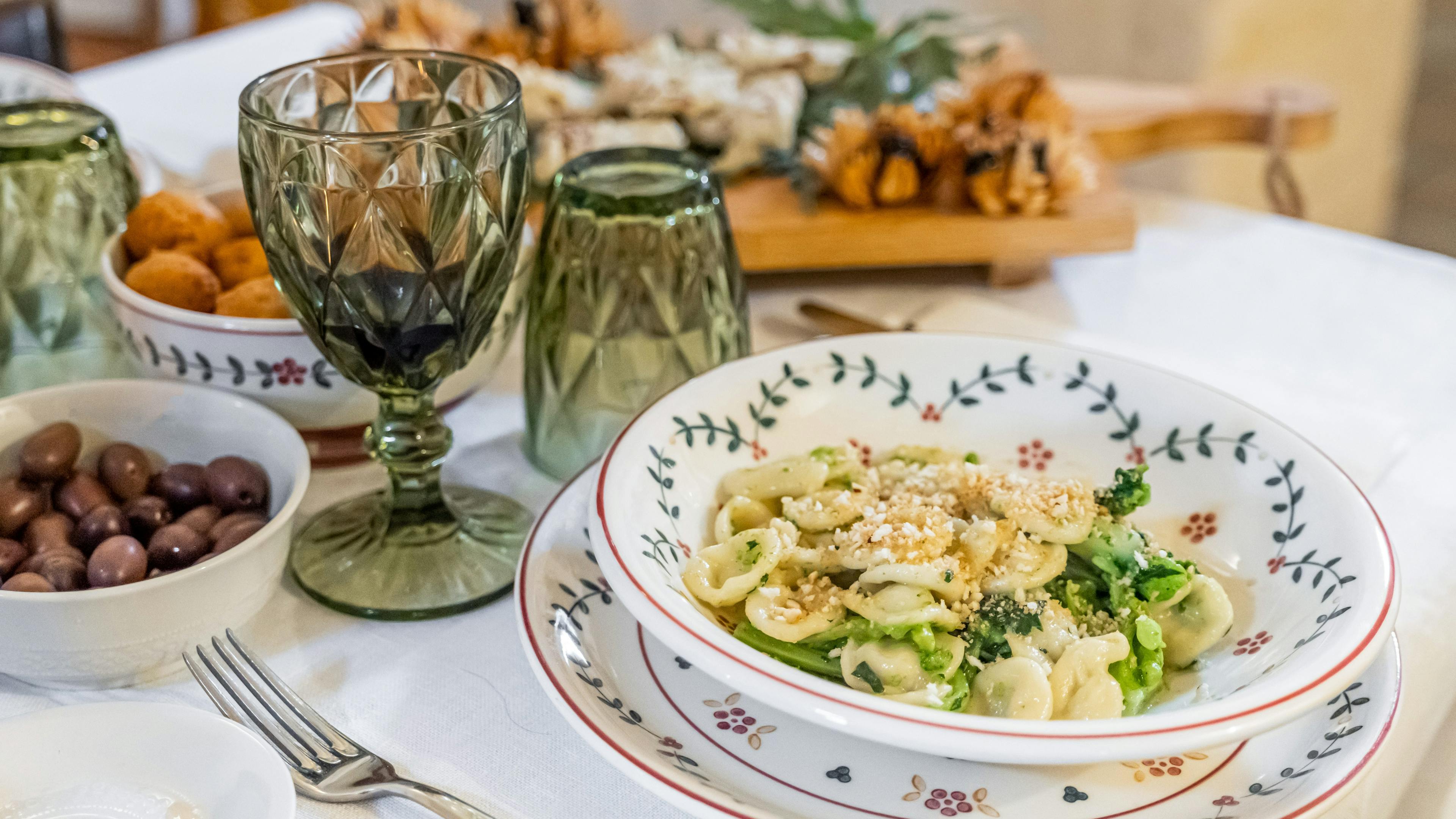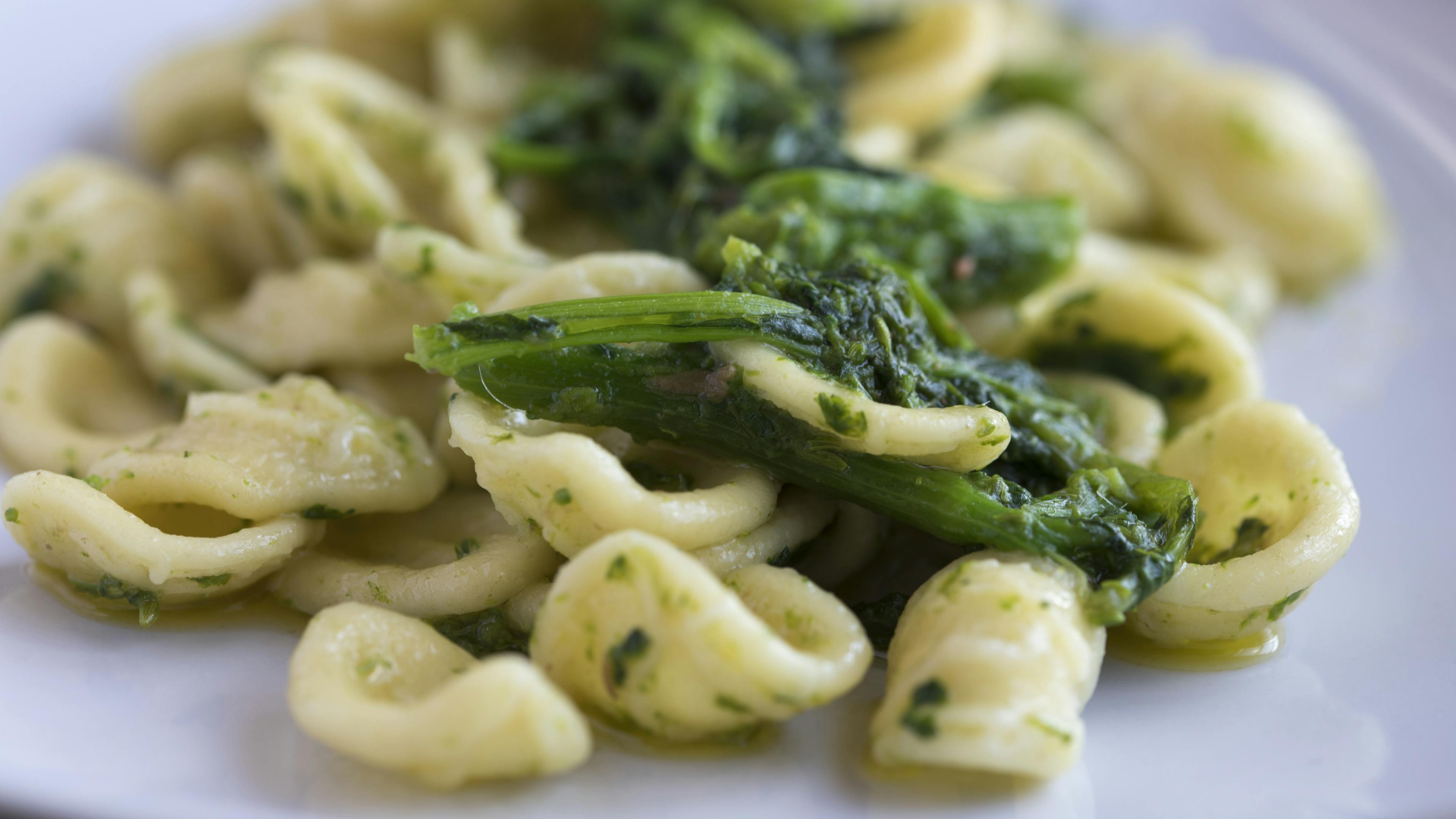

Orecchiette, also known as "recchietelle" in the dialect of Bari, are the symbol of Apulia, a symbol that from the heel of Italy has become famous worldwide. More than just a dish, orecchiette are a true ritual, especially in Apulian households where their preparation and consumption represent the occasion to gather the whole family and bring together different generations side by side: in Bari and in many other Apulian towns, it is common to see grandmothers and grandchildren kneading and shaping these small culinary treasures together.
Orecchiette with turnip tops Recipe
Let's discover together the recipe to prepare this first course and enjoy a healthy, quick, and light lunch!

Orecchiette with turnip tops
The great classic, simple and tasty, symbol of Puglia
Ingredients
- 1 kg of turnip tops
- 2 cloves of garlic
- 1 chili pepper (if desired)
- 50 ml of extra virgin olive oil
- 40 g of chopped almonds
- 100 g of grated homemade bread
- 400 g of re-milled durum wheat semolina flour
- 200/250 ml of water
- Coarse salt (to be added directly to the boiling water)
- Fine salt to taste
Method
For the orecchiette:
- Pour the flour onto a cutting board, forming a well, and add a pinch of salt to the flour. Then pour the room temperature water into the center and start working with your fingers, gradually incorporating the flour, allowing it to absorb the water.
- Knead with your hands until you get a homogeneous and elastic dough. After that, let the dough rest at room temperature for 15 minutes under a cloth.
- After these minutes, take a piece of dough (leaving the rest under the cloth) and work it to form a small roll about 1 centimeter thick.
- From the roll, cut small pieces of dough about 1 cm in size. With a smooth blade knife, shape them into little shells by dragging the piece of dough towards you. After the dragging motion, flip the orecchiette onto themselves.
- Repeat until you finish all the dough.
For the seasoning:
- Take the turnip tops (tip: remove the outer leaves, keeping only the center), cut them into pieces, and immerse them in boiling water with a bit of salt.
- Blanch them for about ten minutes.
- Take the orecchiette and throw them into the water along with the turnip tops and cook everything together, this way the flavors will harmonize perfectly!
- Meanwhile, prepare the seasoning that will make this dish unique. Heat a pan over medium heat and add a drizzle of oil.
- Toast the breadcrumbs, stirring carefully until golden and fragrant.
- Then add the chopped almonds, a touch of refinement that will enhance the flavors of the turnip tops and orecchiette.
- In a small pan over low heat, prepare a sauté with a drizzle of oil, a whole clove of garlic, and, if you like spicy, a chili pepper.
- When the orecchiette and turnip tops are ready, drain them and add them to the sauté, mixing carefully.
- Add some breadcrumbs to give a crunchy note to the dish and mix again.
- And now, the grand finale: carefully plate everything, garnishing with a generous sprinkle of breadcrumbs, like a crown that celebrates the perfection of this Apulian delight.
History of Orecchiette
What is the origin of the "little ears" (orecchiette)? A definite answer does not exist, but what is certain is that their roots sink deeply into the soil of tradition.
According to some, Orecchiette originate from Provence: here, during the Middle Ages, a type of durum wheat pasta with a central hollow called 'crosets' was common. From Provence, they would have been brought to Italy by the Angevins, who ruled over Apulia and Basilicata in the 13th century.
According to others, this pasta was born in Sannicandro di Bari between the 12th and 13th centuries, using durum wheat grown in the Tavoliere delle Puglie. During that period, the area was under Norman-Swabian rule: the local cuisine would have merged with that of the resident Jewish community, giving rise to a pasta similar to the "Haman's ears" (small discs of fried shortcrust pastry) of Jewish tradition, which have a concave and rounded shape just like orecchiette. That shape, moreover, was not dictated by chance but had a precise practical function: the concave shape, favoring the drying process, helped to better preserve the pasta for use in times of famine.
According to other historical sources, the first record of this pasta shape can be found in a 1500 succession deed preserved in the archives of the Basilica of San Nicola in Bari. In that document, a baker bequeathed his business to his daughter, and the dowry also included the preparation of "recchjetedde".
Experiences with Southern Flavors
If you're seeking gastronomic experiences infused with the flavors of the South, take a look at the Mediterranean cooking classes that Cesarine has prepared for you.
Don't miss out on our cooking lessons in Palermo, Naples, Bari, and many other cities, and savor the true spirit of Southern Italy and Mediterranean cuisine with our Cesarine
